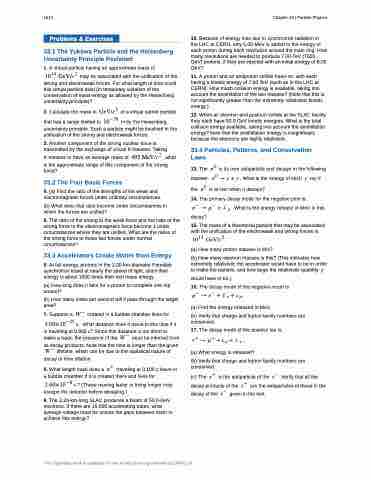Page 1522 - College Physics For AP Courses
P. 1522
1510
Chapter 33 | Particle Physics
Problems & Exercises
33.1 The Yukawa Particle and the Heisenberg Uncertainty Principle Revisited
1. A virtual particle having an approximate mass of
���� ������ may be associated with the unification of the
strong and electroweak forces. For what length of time could this virtual particle exist (in temporary violation of the conservation of mass-energy as allowed by the Heisenberg uncertainty principle)?
2. Calculate the mass in ������ of a virtual carrier particle that has a range limited to ����� m by the Heisenberg
uncertainty principle. Such a particle might be involved in the unification of the strong and electroweak forces.
3. Another component of the strong nuclear force is transmitted by the exchange of virtual K-mesons. Taking
K-mesons to have an average mass of ��� ������ , what is the approximate range of this component of the strong
force?
33.2 The Four Basic Forces
4. (a) Find the ratio of the strengths of the weak and electromagnetic forces under ordinary circumstances.
(b) What does that ratio become under circumstances in which the forces are unified?
5. The ratio of the strong to the weak force and the ratio of the strong force to the electromagnetic force become 1 under circumstances where they are unified. What are the ratios of the strong force to those two forces under normal circumstances?
33.3 Accelerators Create Matter from Energy
6. At full energy, protons in the 2.00-km-diameter Fermilab synchrotron travel at nearly the speed of light, since their energy is about 1000 times their rest mass energy.
(a) How long does it take for a proton to complete one trip around?
(b) How many times per second will it pass through the target area?
7. Suppose a � � created in a bubble chamber lives for
10. Because of energy loss due to synchrotron radiation in the LHC at CERN, only 5.00 MeV is added to the energy of each proton during each revolution around the main ring. How many revolutions are needed to produce 7.00-TeV (7000 GeV) protons, if they are injected with an initial energy of 8.00 GeV?
11. A proton and an antiproton collide head-on, with each having a kinetic energy of 7.00 TeV (such as in the LHC at CERN). How much collision energy is available, taking into account the annihilation of the two masses? (Note that this is not significantly greater than the extremely relativistic kinetic energy.)
12. When an electron and positron collide at the SLAC facility, they each have 50.0 GeV kinetic energies. What is the total collision energy available, taking into account the annihilation energy? Note that the annihilation energy is insignificant, because the electrons are highly relativistic.
33.4 Particles, Patterns, and Conservation Laws
13. The �� is its own antiparticle and decays in the following manner: �� � � � � . What is the energy of each � ray if the �� is at rest when it decays?
14. The primary decay mode for the negative pion is
�� � �� � �� � . What is the energy release in MeV in this
decay?
15. The mass of a theoretical particle that may be associated with the unification of the electroweak and strong forces is
���� ������ .
(a) How many proton masses is this?
(b) How many electron masses is this? (This indicates how extremely relativistic the accelerator would have to be in order to make the particle, and how large the relativistic quantity �
���������� �� What distance does it move in this time if it is traveling at 0.900 c? Since this distance is too short to make a track, the presence of the �� must be inferred from its decay products. Note that the time is longer than the given
(b) Verify that charge and lepton family numbers are conserved.
17. The decay mode of the positive tau is �� � �� � �� � �� � .
(a) What energy is released?
(b) Verify that charge and lepton family numbers are conserved.
(c) The �� is the antiparticle of the �� .Verify that all the decay products of the �� are the antiparticles of those in the
decay of the �� given in the text.
� � lifetime, which can be due to the statistical nature of decay or time dilation.
8. What length track does a �� traveling at 0.100 c leave in a bubble chamber if it is created there and lives for
��������� � ? (Those moving faster or living longer may escape the detector before decaying.)
9. The 3.20-km-long SLAC produces a beam of 50.0-GeV electrons. If there are 15,000 accelerating tubes, what average voltage must be across the gaps between them to achieve this energy?
This OpenStax book is available for free at http://cnx.org/content/col11844/1.14
would have to be.)
16. The decay mode of the negative muon is
� � � � � � �� � � � � .
(a) Find the energy released in MeV.


